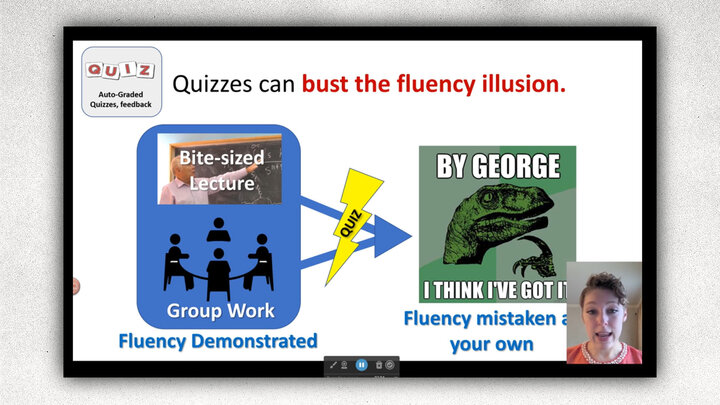In 2016, Chad Brassil, Associate Professor in Biological Sciences, received a College Distinguished Teaching Award in “recognition of consistent excellence in teaching” at the University of Nebraska-Lincoln. But ten years ago, like many other faculty members, he was prepping 8-12 hours for every one hour of class to prepare lecture material for his course.
“It killed me and it was just 50 minutes of me talking to students and occasionally pausing for questions,” Brassil said.
Three years later, still delivering the same material, Brassil said, “It was very easy – only took 15 minutes prep. I lapsed into Encyclopedia Britannica and it was more like a performance. It was an out-of-body experience.”
Shortly thereafter, about the same time MOOCs were gaining mainstream recognition and people were realizing that it was possible to replace ordinary faculty lectures with well-crafted lectures, a graduate student sent Brassil a link to a YouTube video. The video challenged him to justify the brick and mortar college experience.
“That was my first wake-up moment,” Brassil said.
After that, Brassil began to make small, incremental changes based on what he was hearing about learning from a variety of sources. He attended presentations by other faculty, including those specializing in disciplinary-based educational research (DBER), participated in workshops and faculty development like the ARISE program, and eventually began to attend conferences.
Brassil learned that among educational researchers there is no controversy about whether active learning strategies are better than a lecture approach.
“As professors, we’re scientists, but we were ignoring educational science,” Brassil said.
According to Brassil, this was reasonable because at the time much of the educational literature came out of K-12 research and didn’t seem to be as relevant to higher education, especially in the sciences. Additionally, the methods used in that research differed greatly from those familiar to STEM researchers. However, with the emergence of DBER for college science teaching, “We can’t deny it anymore.”
There is keen and growing interest in teaching and learning in the Biological Sciences department with many faculty attending a variety of events. Brassil credited Emeritus Professor Jack Morris with getting things started.
“In the last couple of years before he retired, he stepped out of research to focus on education. More importantly, especially as a pre-tenure faculty myself, he made it ok to focus on that 40% of my job,” Brassil said. “Now that I’m tenured, it’s part of my responsibility to support this,” he added.
One of the things Brassil does to continue what Morris started, is to host Learning Lunches. Topics center on effective teaching and learning strategies. Internal presenters help maximize existing expertise in the department and external presenters bring in new ideas and ways of doing things.
About 8-12 people attend the lunches, but which 8-12 individuals vary. Brassil says the Learning Lunches help localize conversations about teaching and learning and in turn, create a culture of teaching and learning. He says the most important thing to do is keep these types of conversations going and to listen.
According to Brassil, it’s easy for faculty to feel judged when their teaching is observed, but to improve it’s critical to open oneself up to feedback, and especially helpful to receive specific feedback on a particular strategy implementation.
One area of strategies in which Brassil has become something of an on-campus expert are those used in large-enrollment courses.
Two highly effective baby-steps he recommends are using clickers and an approach called “think-pair-share.”
“Clickers let you know if students are getting it right away instead of waiting until an exam. That way you can confidently move forward,” Brassil said.
Think-pair-share is a collaborative learning approach wherein students are given a question, allowed a couple of minutes to consider it individually, after which they are paired with another student. The pair discusses their respective answers, perhaps creating a synthesis or revising their initial ideas and then report out to the class or designated group. This approach may be used in combination with clickers for reporting out.
“You can’t change everything at once. Pick that one thing and do it well and be happy with that,” he advises.
Chad Brassil will be facilitating the March 3, 2017 Teaching and Learning Symposium break-out session, “Strategies for Teaching Large-Enrollment Classes.” In this session, activities proven efficient in terms of learning outcomes and instructor time will be highlighted. Activities from “Teaching for Learning: 101 Intentionally Designed Activities to Put Students on the Path to Success” authored by the keynote presenter will also be featured. Click here to register for the Symposium.
For more information about effective strategies for teaching large enrollment courses, please contact Chad Brassil. For support for trying a new strategy in your class, contact the instructional designer assigned to your college.
This article is part of the February Teaching & Tech Newsletter published by Innovative Instructional Design and is permanently available at this article link.




